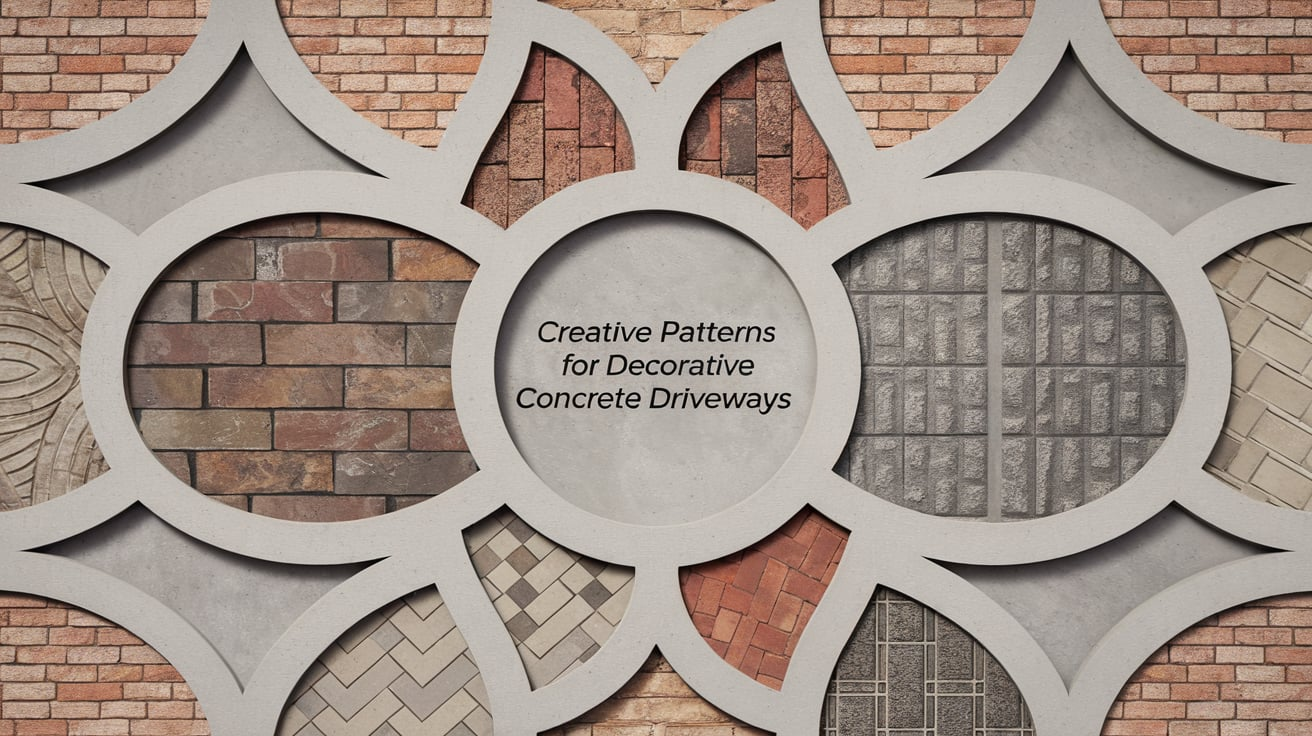Your driveway is more than just where your car sits. It’s one of the first things people see. A basic gray slab can look dull. But you don’t need to settle for plain anymore.
Decorative concrete offers a smart and affordable way to add character to your driveway. It offers the strength of regular concrete but with patterns, textures, and colors that look way better.
Let’s have a look at 12 pattern ideas you can use for your driveway — and how to pick the right one for your home.
What is Decorative Concrete?
Decorative concrete is regular concrete that’s been shaped, colored, or textured to improve its appearance. It can look like stone, brick, wood, tile, or something totally unique.
There are a few ways this is done:
- Stamping: Pressing molds into wet concrete to make patterns.
- Staining: Adding color to change the tone of the surface.
- Scoring or Saw Cutting: Making lines after the concrete hardens to form shapes or designs.
- Exposing Aggregate: Washing off the top layer to show the gravel inside.
This kind of surface gives you more design choices without losing the strength and long life of regular concrete.
Why Choose a Decorative Concrete Driveway?
One big reason people like decorative concrete is the mix of looks and function. It holds up just as well as plain concrete but looks way more inviting. Plus, it doesn’t cost as much as stone or pavers.
It handles all kinds of weather, needs little work to keep it clean, and lets you add personal style without a lot of effort. You can match it to your home, your yard, or even your sidewalk.
It also helps with resale. A good-looking driveway makes your house look better overall, which can be helpful if you ever want to sell.
Here is a series of decorative driveway ideas you’ll like.
1. Stamped Brick Pattern
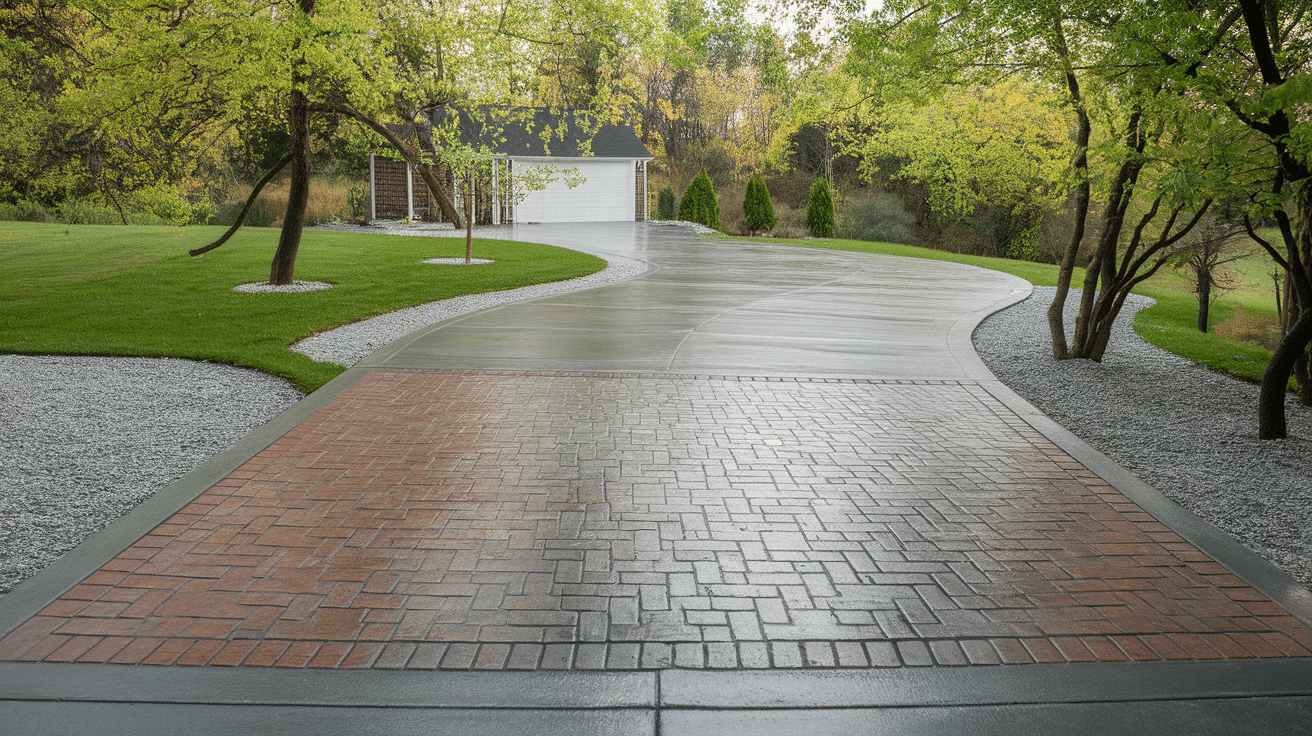
This one copies the look of bricks laid out in rows. A special mat is pressed into the wet concrete to make the lines and shapes. Once it dries, it looks like real brick but doesn’t cost as much.
It works well for homes with a classic or traditional look. You can also pick from a range of colors — red, brown, gray, or even faded tones — to fit your style.
Unlike real bricks, this surface doesn’t shift over time or need sand between gaps. It stays smooth and strong while keeping that clean brick style.
2. Ashlar Slate
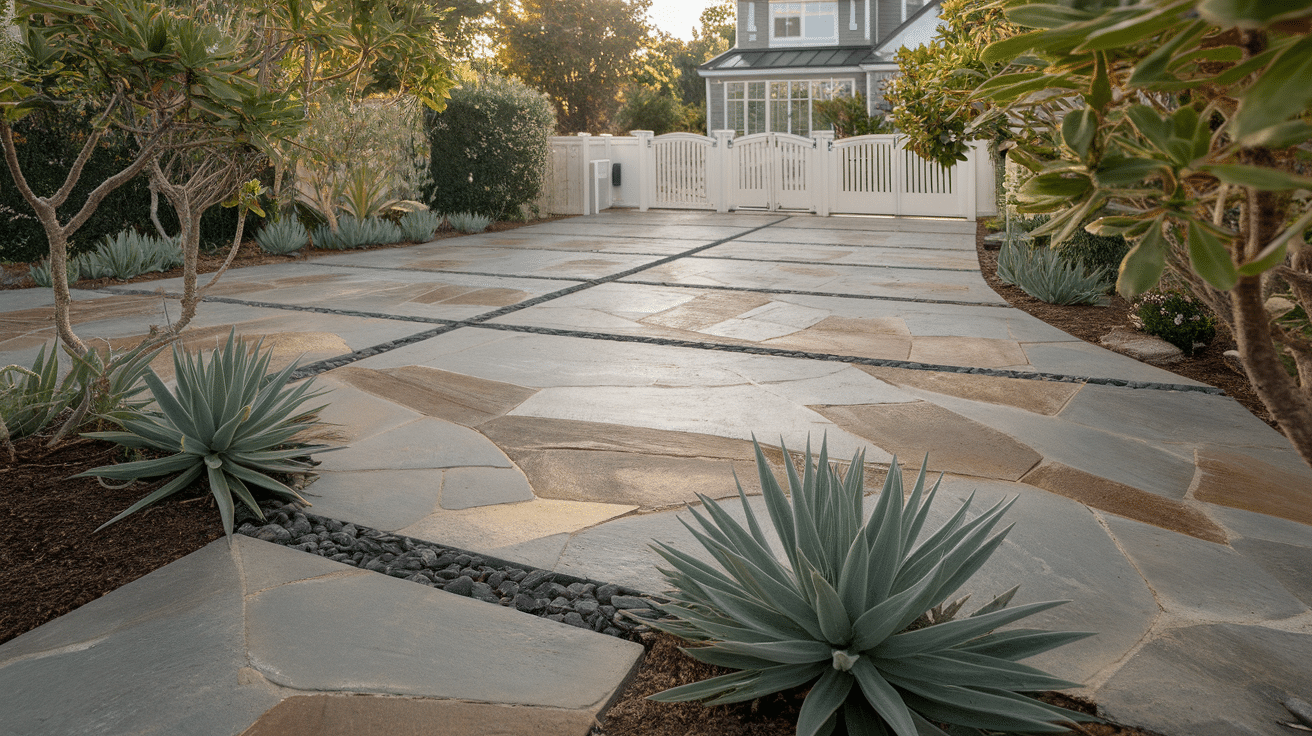
Ashlar slate is made to look like cut stones placed in a repeating pattern. The stones vary in size but still fit neatly like a puzzle.
This design gives a calm and clean look without being too plain. It fits well with homes that have stone, brick, or wood walls.
It’s also one of the most popular choices because it adds detail without going overboard. The surface has some texture, so it’s safer to walk or drive on when it’s wet.
3. Herringbone Pattern
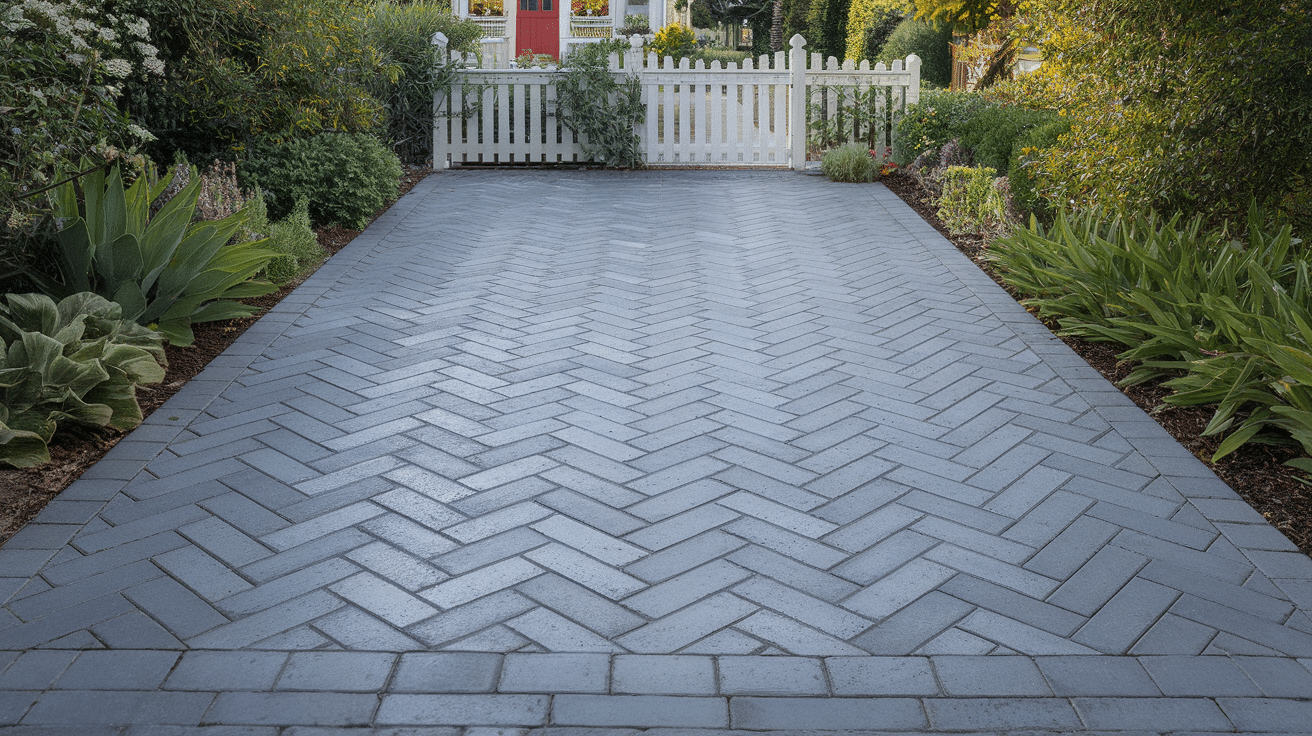
A herringbone pattern is made of short rectangles placed in a zigzag pattern. The rows meet at angles, giving the surface a strong visual effect.
This pattern has been used for centuries in roads and buildings. It adds a rich, structured look to the driveway. It’s also great for driveways that are long and narrow, since it gives the illusion of more width.
The pattern makes it harder for cracks to spread in a straight line, which helps with wear and tear over time.
4. Cobblestone Stamp
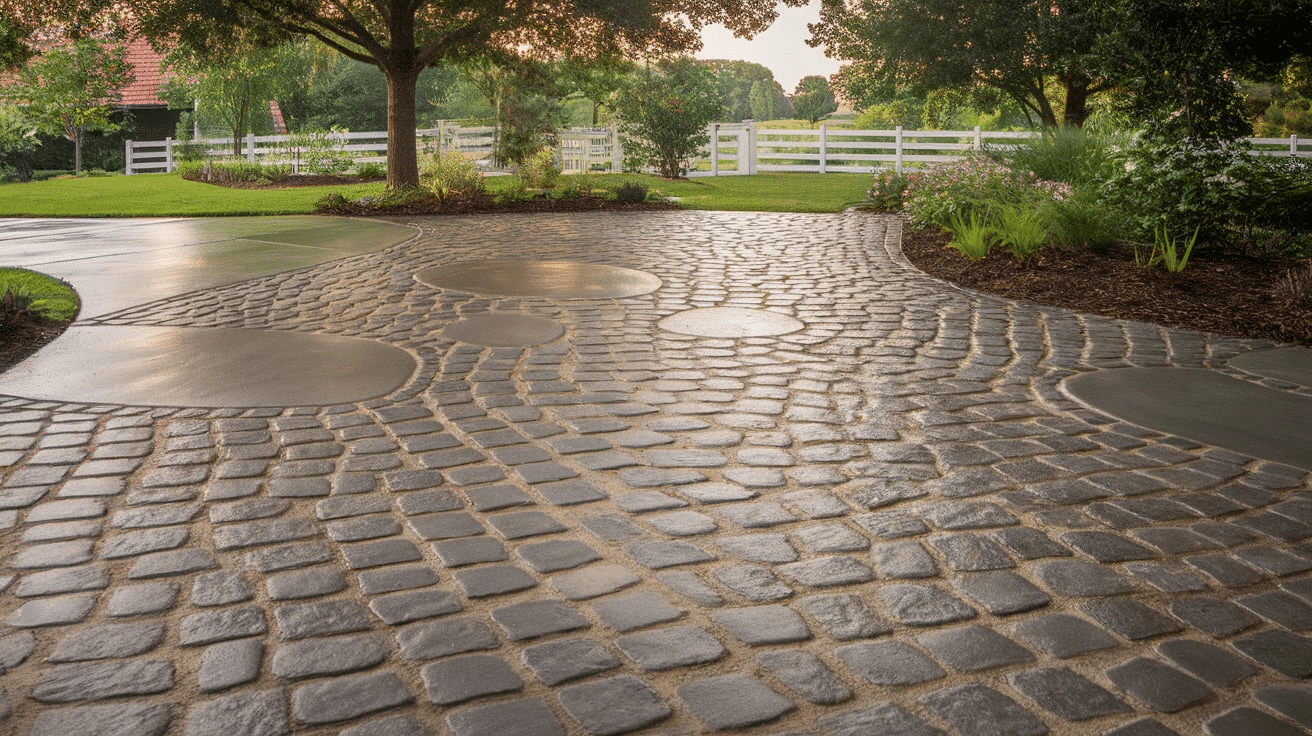
Cobblestone has that old-world feel. It looks like rounded stones placed tightly together, like streets in old towns.
This pattern adds a lot of texture and character. It fits well with older-style homes, garden-style front yards, or curved driveways.
It also provides great grip for tires, especially in areas where it rains or snows. Because the pattern is uneven, it can catch light in interesting ways throughout the day.
5. Wood Plank Look
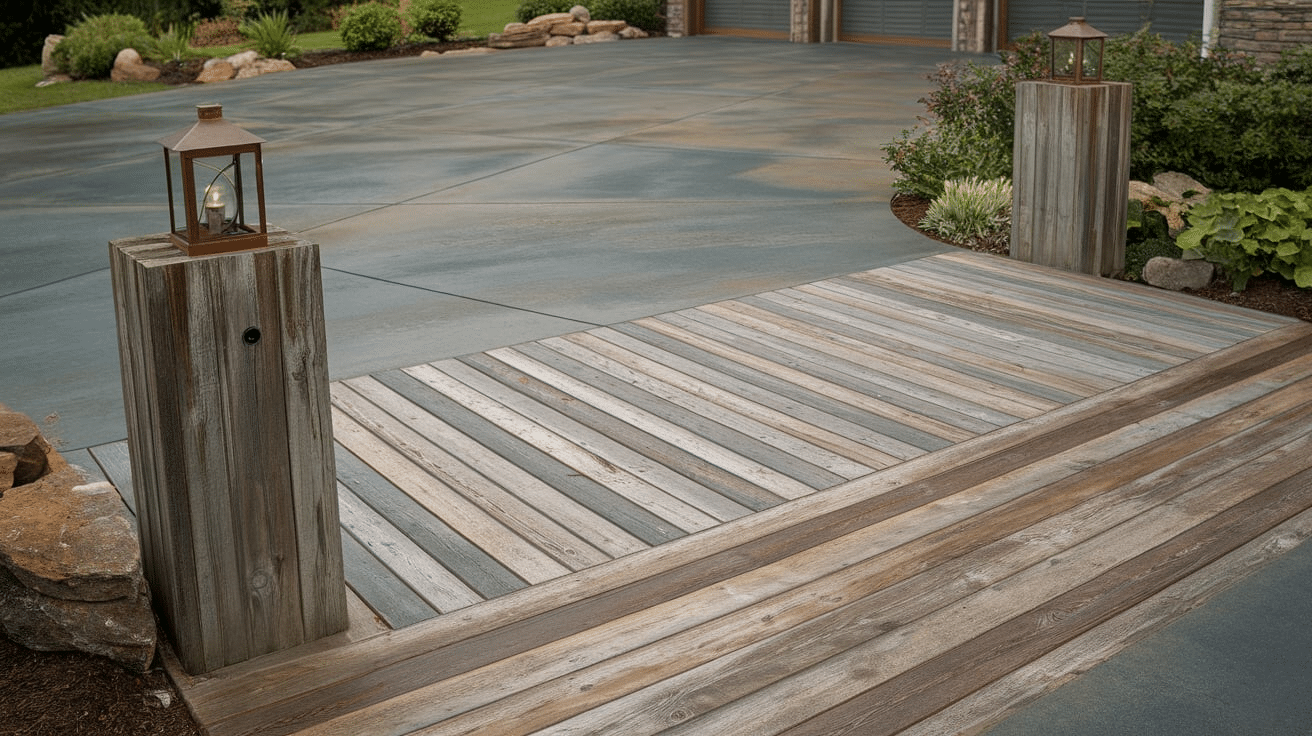
Concrete can also be stamped to look like wooden boards. You still get the natural, warm feel of wood — but with none of the problems like rot, termites, or splinters.
This design works best for driveways that lead into wood-framed houses or blend into garden areas.
You can choose how wide the planks are, what grain pattern shows, and even the color. It’s also easy to clean and doesn’t need sanding or staining like real wood.
6. Exposed Aggregate
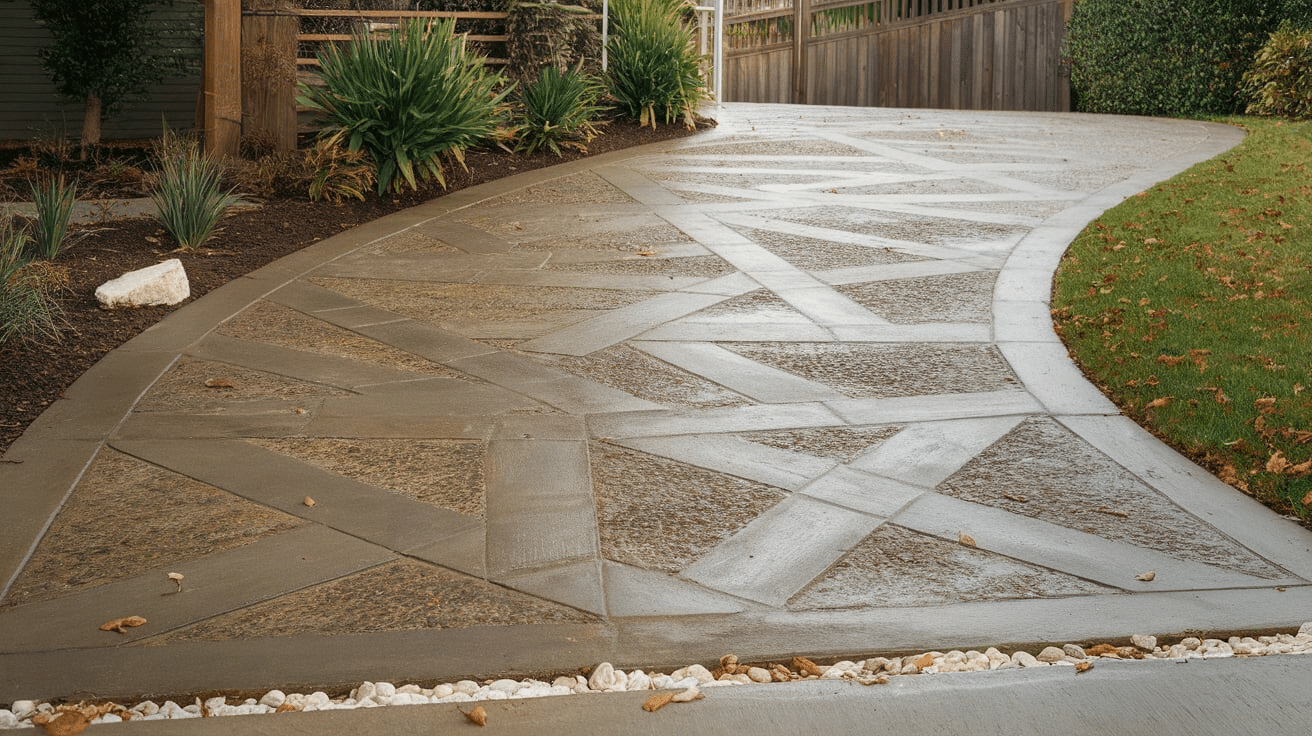
Instead of stamping a shape, this design uses the natural gravel in the concrete. Once poured, the top layer is washed off to show the small stones inside.
Each driveway has its own look based on the type of stones used. You might see pebbles, river rocks, or crushed glass.
This surface is rough, which helps with traction. It’s great for sloped driveways or places that get wet often. It also doesn’t show dirt or stains as easily as smooth concrete.
7. Seamless Texture
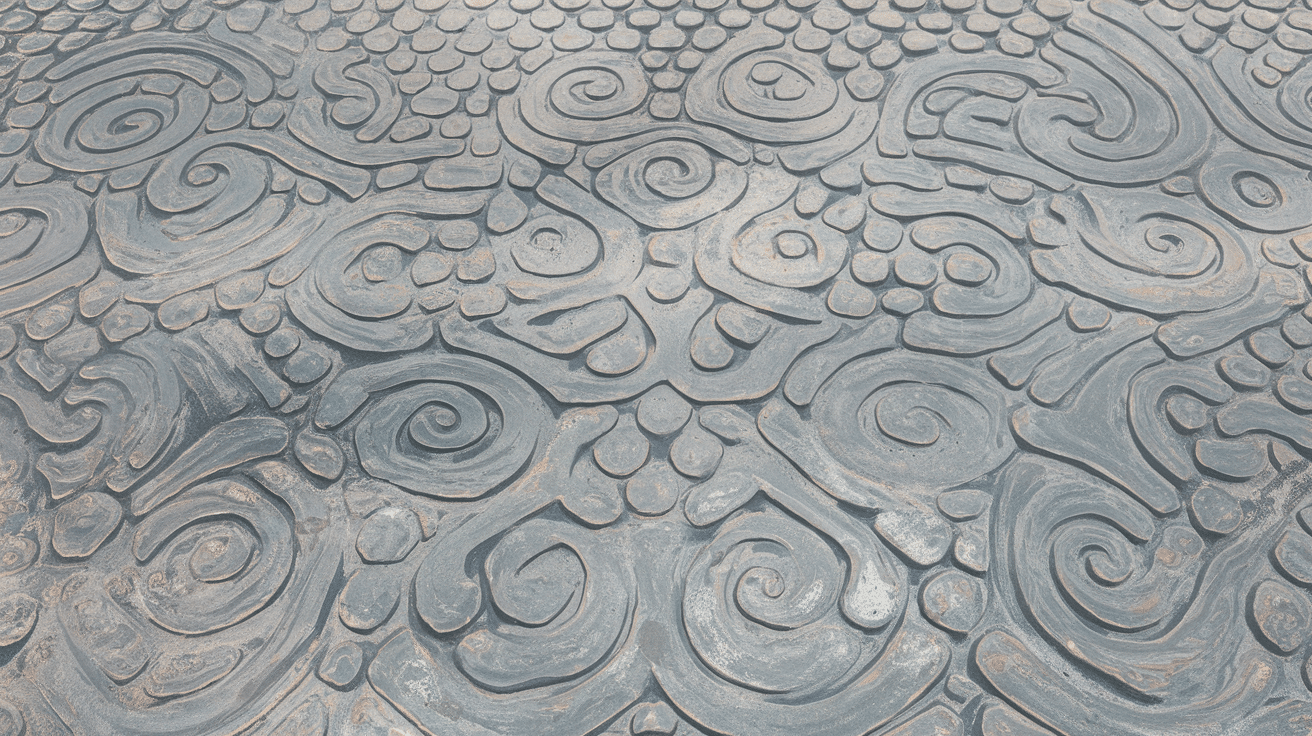
Seamless texture skins are big stamps with no lines or shapes. They press a light texture into the concrete — like stone, leather, or sand.
This is perfect for people who want a smooth, modern feel without lines or breaks. It’s simple but still looks finished.
This style works well on large areas and can match patios, sidewalks, or garages without looking too busy.
8. Basketweave Pattern
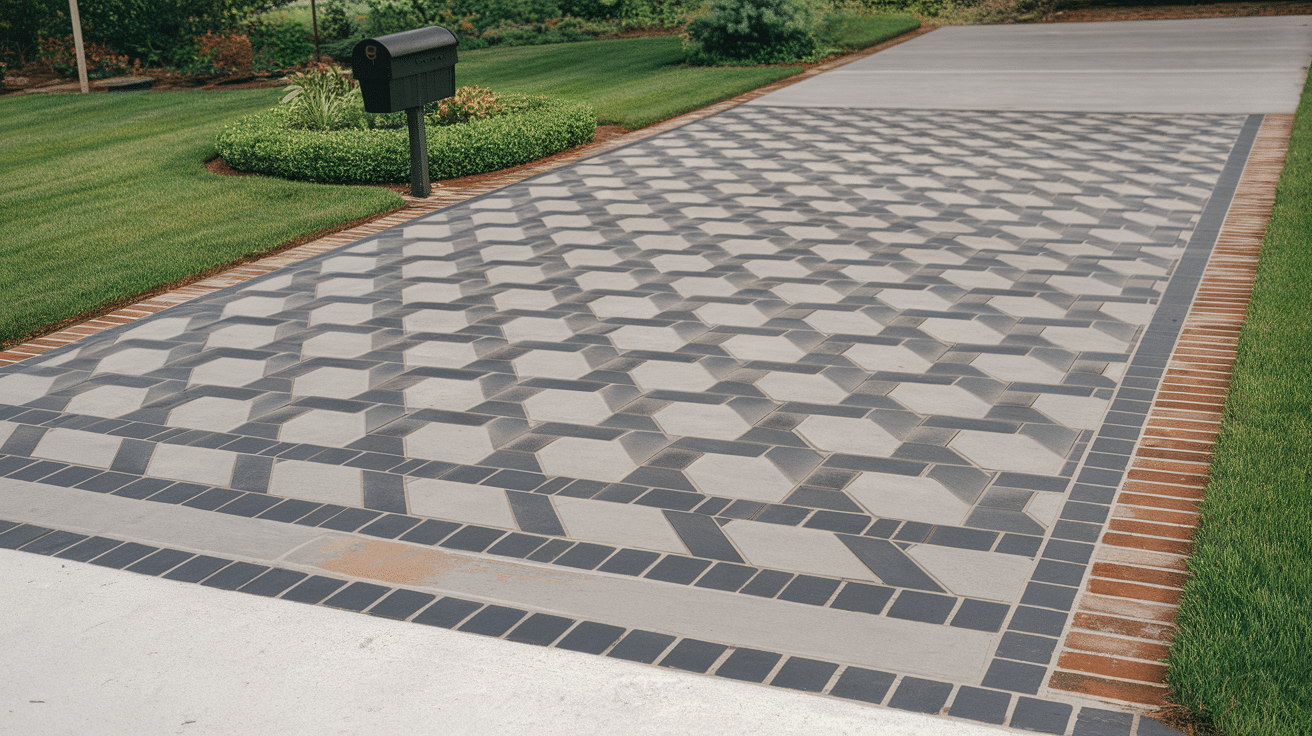
Basketweave looks like two bricks placed across another two, creating a woven effect. It’s been used for hundreds of years in garden paths and driveways.
This style brings a handcrafted feel to the driveway. It works best for short or medium-length driveways where you want a tight pattern.
You can mix light and dark tones in the brick design to make the pattern stand out more.
9. Border and Center Mix
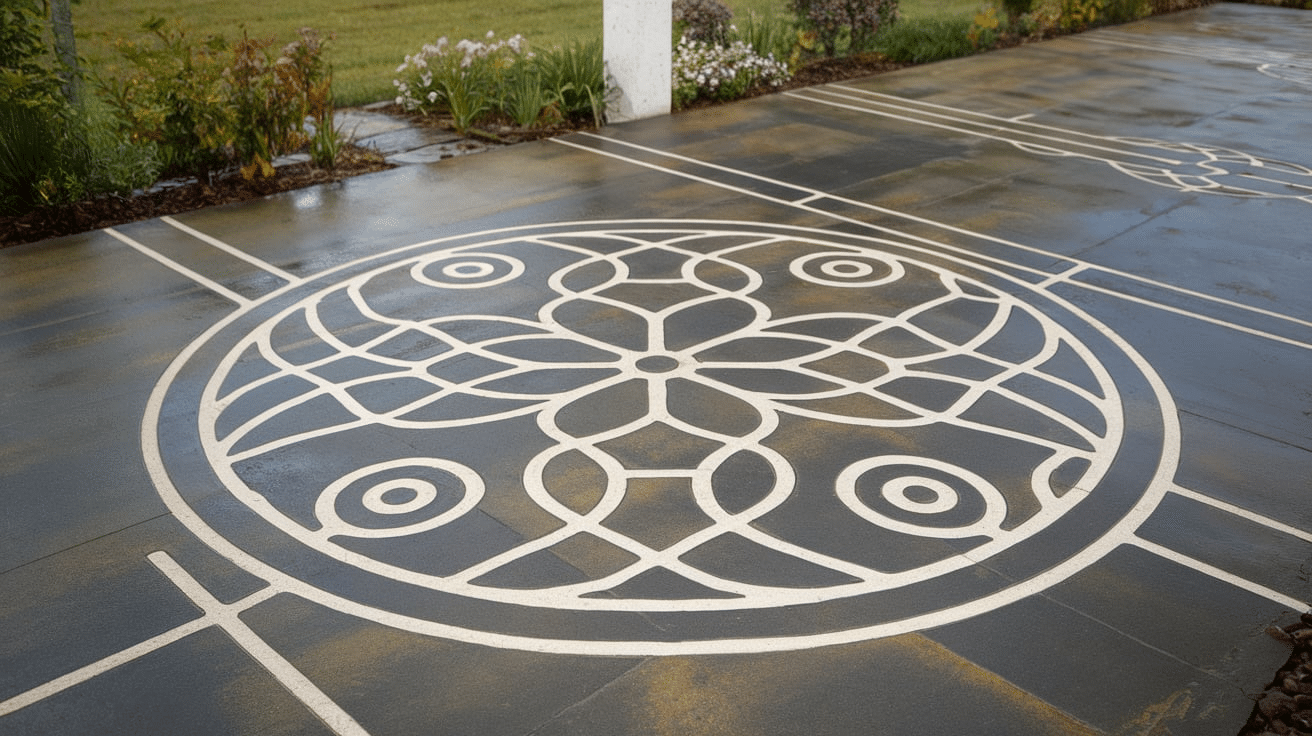
A clever way to save money and still get a strong look is to focus the pattern on just the border.
For example, the main area might be smooth concrete or light stamp, and the edges might have a bolder look like brick, stone, or slate.
This adds interest without making the whole surface busy. It also lets you mix styles — maybe a wood plank center with stone edges. You can also highlight curves, steps, or entry points using this method.
10. Diamond-Cut Lines
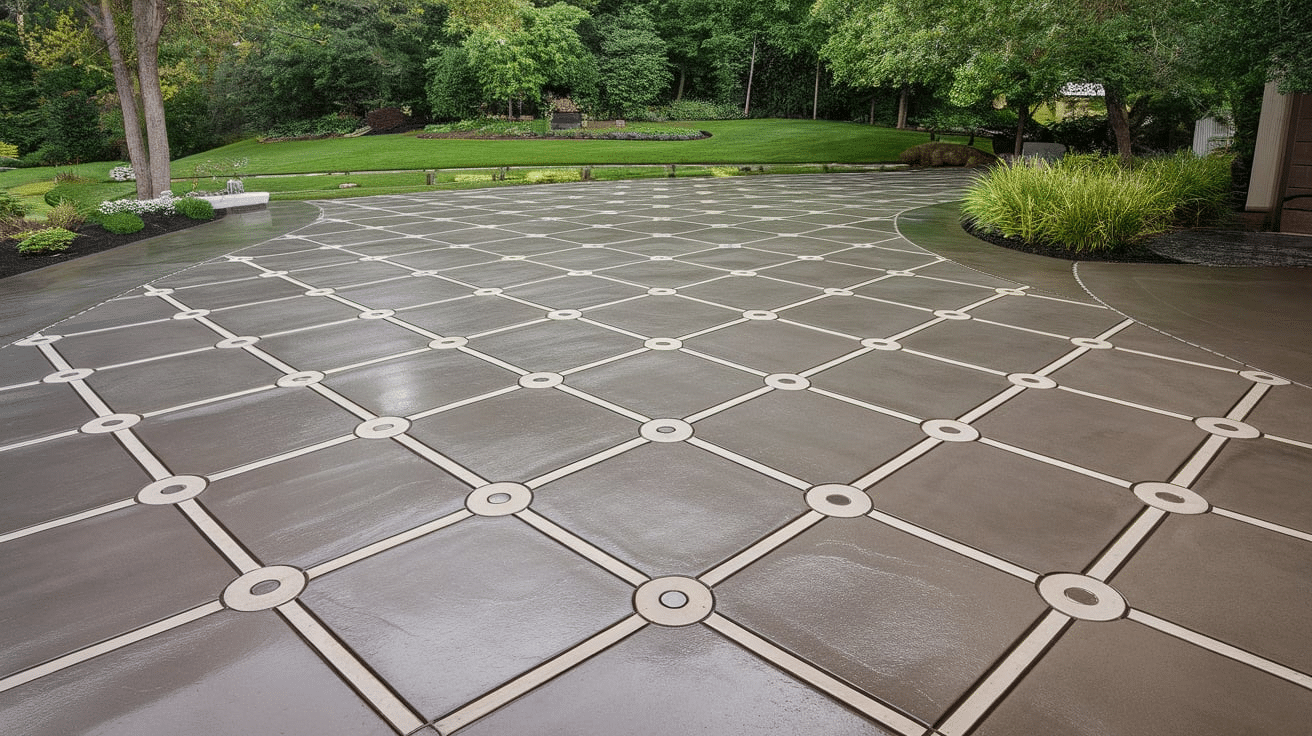
You don’t always need stamps to get a pattern. You can use a saw to cut the surface into large diamond shapes after the concrete hardens.
This method is clean, modern, and fits well with homes that have sharp lines or flat roof styles.
It’s often combined with stain to give contrast between the shapes. You can also choose how deep or wide the lines are.
It’s a good option if you already have a concrete driveway and want to upgrade it.
11. Random Stone
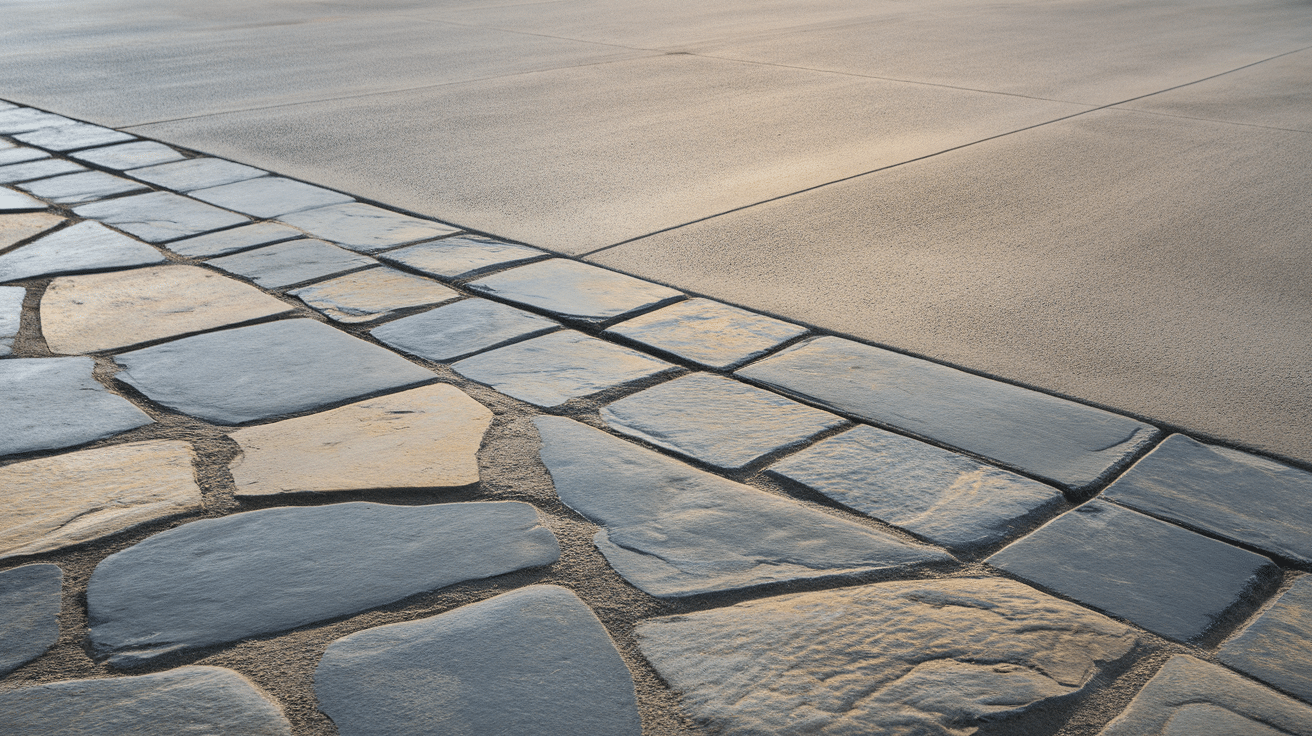
This design copies how natural stones might be laid on the ground. The stones are of different sizes and shapes, giving the driveway a laid-back and natural look.
The design breaks up large flat areas and helps the driveway blend with gardens or green spaces.
It’s perfect for wider driveways or homes surrounded by trees and plants. Each stone shape is different, so no two driveways look the same.
12. Stained and Scored
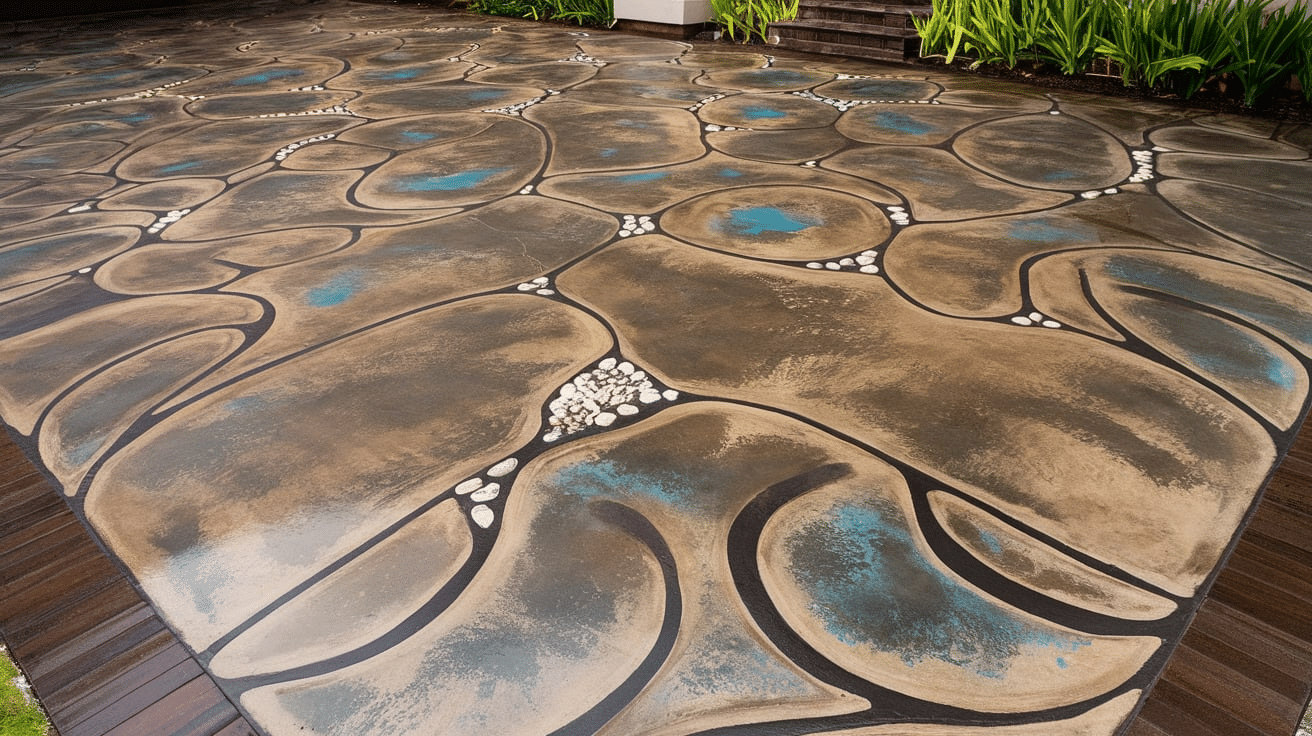
This is one of the easiest ways to change how your driveway looks — even if it’s already poured.
Concrete stain adds color, while shallow cuts make shapes like tiles or large squares. It’s simple, affordable, and quick to do.
You can go for a warm brown tone, a cool gray, or even a reddish tint. When the scoring is done neatly, it gives a clean tiled look without using actual tiles.
What to Think About Before Picking a Pattern
Home Design
Your driveway should match the shape and style of your home. If your home has strong lines, go with patterns like diamond cuts. If it’s softer and rounded, maybe go with cobblestone or slate.
Weather
Some patterns, like exposed aggregate or stamped texture, provide better grip in rain or snow.
Budget
Stamped concrete costs more than plain, and complex designs take longer to install. You can save money by choosing smaller patterns or using pattern only on the border.
Maintenance
All decorative concrete should be sealed. Some patterns, like exposed aggregate or deep stamps, might collect more dirt and need more care.
Cost of Decorative Concrete Driveways
Costs change depending on the area, pattern, and the amount of detail. Here’s a rough idea:
-
Basic color or stain: $8–$12 per square foot
-
Stamped or patterned: $12–$18
-
Detailed work (multi-pattern, color + stamp): $18–$28+
Borders, steps, and sealing add to the cost. But even at the high end, it’s often still cheaper than stone or pavers.
How to Take Care of It
Sealing is the best way to keep your driveway looking good. It protects the surface from stains, sun, and rain.
Use mild soap and water to clean dirt. Don’t use strong salt in winter; it can damage the surface. Fix small cracks early to stop them from getting worse.
With good care, decorative concrete can last 30 years or more.
Conclusion
Your driveway isn’t just a slab of concrete. It’s a part of your home’s outside space — and it says a lot about how you care for your place.
With decorative concrete, you can keep all the benefits of concrete — strength, long life, and low work — while also choosing a look that fits your home.
The patterns above offer something for everyone. You might like the feel of bricks, the smooth style of stone, or even the clean look of scored lines. There’s no single “best” option. It just depends on what feels right for your home and your taste.
When done right, a decorative concrete driveway isn’t just useful — it’s something you’ll enjoy coming home to every single day.
Frequently Asked Questions
Will a decorative concrete driveway crack?
Yes, all concrete has the chance to crack over time. But if it’s poured correctly and has the right control joints (the lines cut into it to guide cracks), it should hold up well. Regular sealing can also help prevent cracks from growing.
Can you add patterns to an old driveway?
Yes, you can. If your current driveway is still in good shape, you can stain it or cut patterns into it. You don’t always have to tear it out to get a fresh look.
How long does installation take?
Most decorative concrete driveways take between 3 and 7 days to install. The time depends on the size, weather, and how complex the pattern is. Extra steps like staining, stamping, and sealing can add time.
How often do I need to reseal it?
Sealing every 2 to 3 years is a good rule. If your area gets a lot of sun, rain, or snow, you may need to seal it a bit more often. A good sealer keeps the color fresh and protects the surface.
Is it safe to drive and walk on?
Yes, as long as it’s finished with a texture or a non-slip surface. Patterns like cobblestone, wood plank, or exposed aggregate give a better grip. Smooth concrete can get slippery when wet, so it’s not used as much for driveways anymore.

